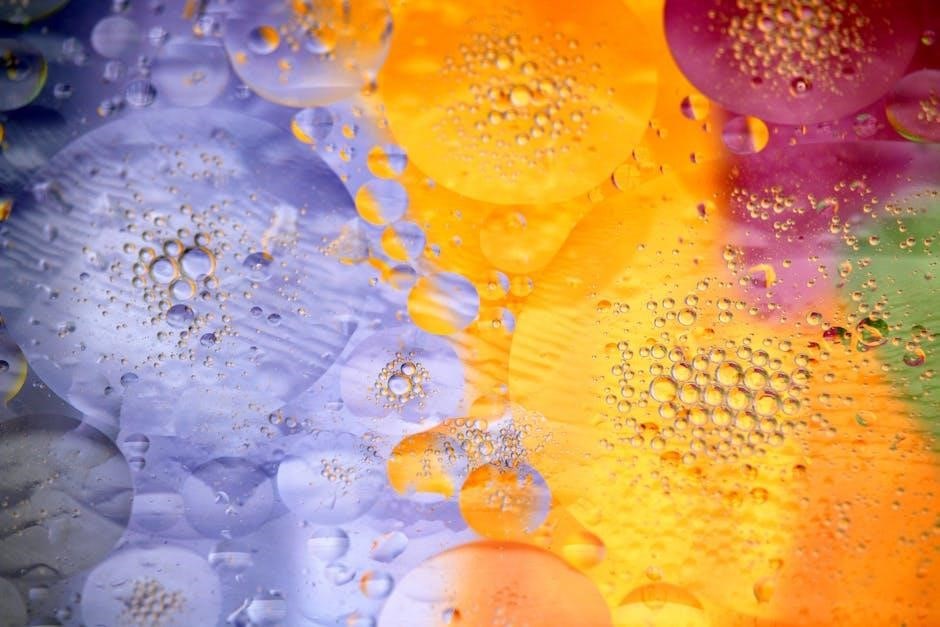color mixing chart pdf
A color mixing chart is a practical tool for artists and educators, offering a visual guide to understanding color theory and mixing ratios. Available as PDF downloads, these charts provide pre-designed templates that simplify the process of creating custom color combinations, helping to achieve consistent results in paintings and artistic projects.
1.1 What is a Color Mixing Chart?
A color mixing chart is a visual tool designed to help artists and educators understand how different colors interact when mixed. It provides a structured layout, often available as a PDF, that showcases primary, secondary, and tertiary colors, along with their various combinations. This chart serves as a practical guide for learning color theory, allowing users to experiment with mixing ratios and create custom hues. Whether you’re a beginner or an experienced artist, a color mixing chart is an essential resource for achieving consistent and predictable results in your artistic projects, ensuring vibrant and balanced color palettes every time.
1.2 Importance of Color Mixing Charts for Artists and Educators
A color mixing chart is an invaluable tool for artists and educators, providing a clear and organized way to understand color theory and mixing ratios. It helps artists predict outcomes, prevent muddy mixes, and create balanced palettes. For educators, it serves as a visual aid to teach fundamental concepts of color interaction, making complex ideas accessible to students. The chart’s pre-designed templates, often available as a PDF, save time and streamline the learning process. Whether used in a classroom or studio, a color mixing chart is essential for fostering creativity, consistency, and confidence in artistic endeavors, making it a must-have resource for both beginners and experienced creators.
1.3 Benefits of Using a Color Mixing Chart PDF
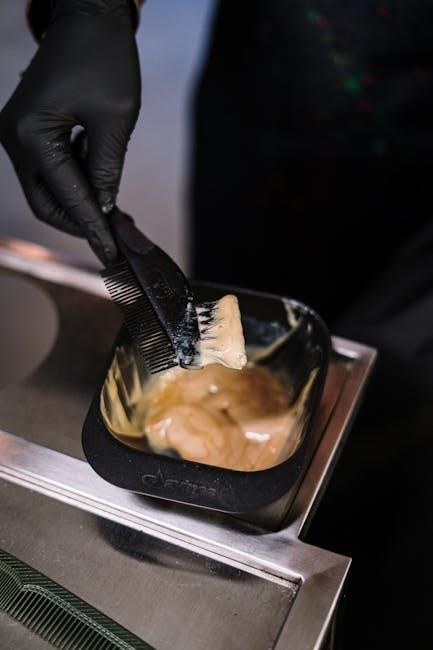
A color mixing chart PDF is a practical tool for artists and educators, offering a visual guide to understanding color theory and mixing ratios. It provides pre-designed templates that simplify the process of creating custom color combinations, helping to achieve consistent results in paintings and artistic projects. The PDF format allows for easy printing and reference, making it a convenient resource for both studio and classroom use. By using a color mixing chart, artists can save time, prevent muddy mixes, and explore endless creative possibilities. It is an essential resource for anyone looking to master color mixing and enhance their artistic skills.
Basics of Color Theory
Understanding the fundamentals of color theory is essential for mastering color mixing. It involves primary, secondary, and tertiary colors, the color wheel, and how they interact to create harmonious palettes and balanced compositions.
2.1 Primary, Secondary, and Tertiary Colors
Primary colors—red, yellow, and blue—are the foundation of color theory, as they cannot be created by mixing other colors. Secondary colors (orange, green, and violet) are formed by mixing two primary colors. Tertiary colors result from combining primary and secondary colors, creating hues like yellow-green or blue-violet. These color categories are essential for understanding how to mix and create new shades, forming the basis of any color mixing chart. By mastering these fundamentals, artists can experiment with diverse palettes and achieve desired effects in their work; This knowledge is crucial for both traditional and digital art, ensuring consistency and creativity in color application.
2.2 Understanding the Color Wheel
The color wheel is a circular diagram that organizes colors based on their relationships and hues. It begins with primary colors (red, yellow, blue) and progresses to secondary colors (orange, green, violet), formed by mixing primaries. Tertiary colors are created by blending primary and secondary colors, resulting in shades like yellow-green or blue-violet. The color wheel also illustrates warm colors (red, orange, yellow) and cool colors (blue, green, violet), helping artists understand contrast and harmony. A color mixing chart PDF often includes a color wheel to visually guide artists in creating balanced palettes and identifying complementary colors for vibrant or muted effects. This tool is indispensable for both traditional and digital art, enhancing creativity and precision in color selection and mixing.
2.3 Proportional Mixing and Tone Adjustments
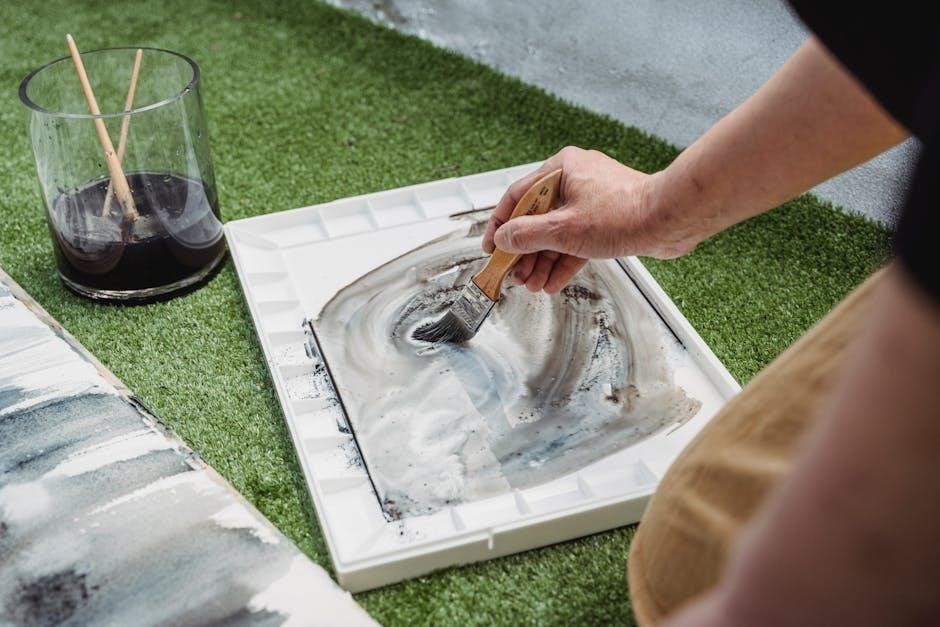
Proportional mixing involves combining colors in specific ratios to achieve desired hues and shades. This technique allows artists to create consistent results by measuring the amounts of each color used. A color mixing chart PDF often includes grids or templates to help visualize these proportions, making it easier to replicate mixes accurately. Tone adjustments refer to altering the lightness or darkness of a color by adding black, white, or gray. This process enables artists to fine-tune their mixes for specific effects, such as creating subtle gradients or enhancing contrast in a painting. Understanding these principles is essential for mastering color harmony and achieving the desired visual impact in artistic works.
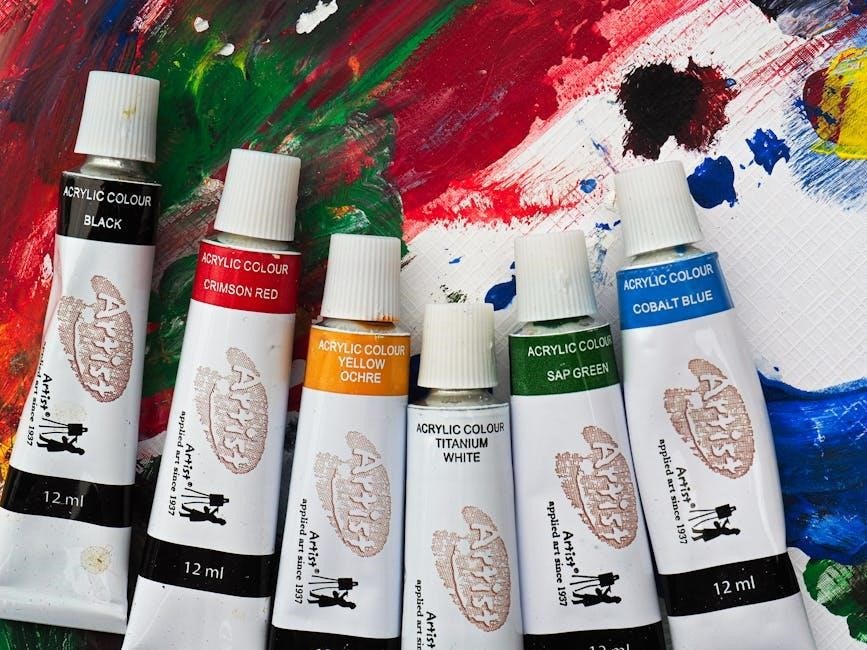
The Science of Color Mixing
The science of color mixing involves understanding how colors interact when blended, with pigments determining light absorption and reflection, enabling consistent results in artistic creations.
3.1 How Colors Interact When Mixed
When colors are mixed, they interact based on their hue, chroma, and the pigments used. Primary colors (red, yellow, blue) create secondary colors (orange, green, purple) when blended. Tertiary colors emerge from mixing primary and secondary hues, offering richer tones. The proportion of each color in a mixture determines the final shade, with ratios critical for achieving desired results. Understanding how colors interact is essential for predicting outcomes and creating balanced palettes. Tools like a color mixing chart PDF provide visual guidance, simplifying the process of experimenting with color combinations and ensuring consistent results in artistic projects.
3.2 The Role of Pigments in Color Mixing
Pigments are the core components of color mixing, determining how colors behave when combined. Each pigment has unique properties, such as transparency, translucency, or opacity, which affect the final mixture. Transparent pigments allow light to pass through, creating deep, rich tones, while opaque pigments block light, resulting in brighter, more vivid colors. The interaction of these properties influences the strength and hue of the mixed color. A color mixing chart PDF often categorizes pigments by their characteristics, helping artists predict and achieve desired outcomes. This understanding is crucial for mastering color mixing in various mediums, from acrylics to watercolors, ensuring consistent and predictable results in artistic creations.
3.3 Achieving Consistent Results in Paintings
Achieving consistent results in paintings relies heavily on understanding color mixing principles and using tools like a color mixing chart PDF. These charts provide a visual guide to color ratios and pigment behavior, ensuring reproducible outcomes. By standardizing the proportions of primary and secondary colors, artists can maintain uniformity across projects. Additionally, understanding pigment properties, such as transparency and opacity, helps predict how colors will interact. This consistency is especially crucial for professional artists, as it ensures reliability and quality in their work. A well-organized color mixing chart serves as a timeless reference, empowering artists to create with confidence and precision, saving time and materials in the process.
Tools and Resources for Color Mixing
Essential tools include Liquitex color charts, digital color mixing apps, and printable PDF templates. These resources provide detailed guides for creating custom color combinations and achieving consistent results.
4.1 Liquitex Color and Pigment Chart
The Liquitex Color and Pigment Chart is a comprehensive resource for artists, organizing colors by hue and chroma. It categorizes pigments as transparent, translucent, or opaque, helping artists understand their properties. This chart is particularly useful for acrylic painters, as it details how colors interact and mix. It also allows for experimentation with different viscosities, such as combining heavy body and fluid acrylics. The chart is a valuable tool for achieving consistent results and exploring creative possibilities in color mixing. Artists can use it to plan palettes, test ratios, and ensure their desired effects are achieved in their work.
4.2 Digital Tools for Color Mixing
Digital tools for color mixing offer innovative ways to explore and create custom palettes. Software like Adobe Color and online mixers allow artists to experiment with color combinations digitally, providing real-time adjustments and precise ratios. These tools often include features like color wheels, hex code generators, and light/dark value adjustments. Many digital platforms also offer downloadable PDF guides and printable templates, making it easy to transfer digital designs to physical art. Additionally, apps and websites provide tutorials and resources for mastering color theory and mixing techniques. These tools are invaluable for both traditional and digital artists, enhancing creativity and precision in their work.
4.3 Printable Color Mixing Templates
Printable color mixing templates are essential resources for artists, providing structured layouts to experiment with and record color combinations. Available as downloadable PDFs, these templates often include grids, color wheels, and mixing guides. They are ideal for both acrylic and watercolor artists, allowing for precise documentation of pigment ratios and results. Many templates are customizable, enabling artists to focus on specific color palettes or techniques. By using these tools, artists can create consistent and predictable outcomes, making them invaluable for educational purposes and studio practice. Printable templates also serve as a convenient reference for future projects, enhancing creativity and efficiency in the artistic process.
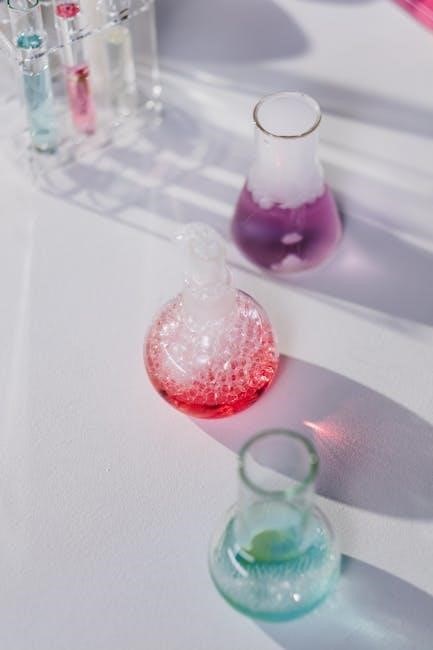
Creating a Custom Color Mixing Chart
A custom color mixing chart involves painting color swatches on a grid, mixing paints to create new hues, and labeling each combination for future reference, ensuring accuracy and consistency in artistic projects.
5;1 Materials Needed for a DIY Chart
To create a custom color mixing chart, you’ll need acrylic or watercolor paints, a palette, paintbrushes, and a surface like canvas or heavy paper. Optional materials include a printer for PDF templates and a laminator for durability. Start by selecting your most-used colors and organizing them in a grid format. Label each color swatch clearly and document the mixing ratios. This hands-on approach allows you to experiment with different combinations, ensuring a personalized and practical tool for your artistic projects. Organize your chart logically to make it easy to reference when mixing colors in the future.
5.2 Step-by-Step Guide to Making a Chart
Start by creating a grid layout on your surface using a ruler or template. Apply small swatches of each primary and secondary color, leaving space for mixing. Label each color clearly. Next, mix complementary colors in varying ratios, documenting the results. Include tints, tones, and shades by adding black or white. Organize the chart logically, grouping similar hues together. For accuracy, test each mixture on a separate surface before committing it to the chart. Finally, seal your chart with varnish or laminate it for durability. This hands-on process ensures a personalized and practical tool for future reference, enhancing your understanding of color relationships and mixing techniques.
5.3 Organizing and Labeling Your Chart
Organize your chart by arranging colors in a logical sequence, such as primary, secondary, and tertiary hues. Label each color swatch clearly with its name and brand for easy reference. Include mixing ratios and the resulting shades or tints. Use a marker to write notes on color properties, such as opacity or lightfastness. Consider adding a legend to explain symbols or abbreviations. For digital charts, use layers and clear typography to enhance readability. Finally, protect your chart by laminating it or sealing it with varnish. A well-organized and labeled chart becomes an indispensable reference tool, saving time and ensuring accurate color reproduction in your artistic projects.
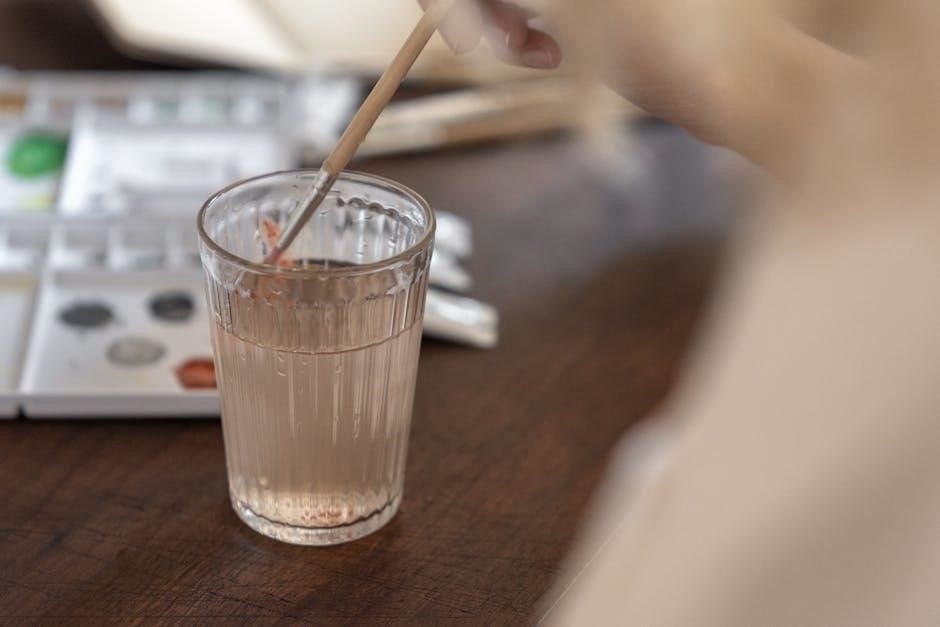
Applications of Color Mixing Charts
Color mixing charts are versatile tools for acrylic, oil, and watercolor painting, as well as digital art. They help artists create harmonious palettes, explore color combinations, and achieve consistent results across various mediums.
6.1 Acrylic Paint Color Mixing
A color mixing chart is invaluable for acrylic paint artists, offering a visual guide to explore color combinations and ratios. By organizing primary, secondary, and tertiary colors, artists can create vibrant, balanced palettes. The chart simplifies mixing heavy body and fluid acrylics, even across brands, ensuring consistent results. It also helps prevent muddy mixes by illustrating how to layer and blend colors effectively. Whether mixing student-grade or professional paints, a chart provides clarity and confidence, making it an essential tool for both beginners and experienced artists to enhance their acrylic painting techniques.
6.2 Oil Paint Color Mixing
A color mixing chart is a vital resource for oil paint artists, providing a detailed guide to achieving precise color combinations and textures. Oil paints, known for their blending and layering capabilities, benefit greatly from a chart that illustrates how to mix primary, secondary, and tertiary colors. It also helps in understanding the role of mediums and pigments in creating rich, vibrant hues. By referencing a chart, artists can avoid muddy mixes and ensure consistent results. Whether working on landscapes, portraits, or abstracts, a color mixing chart enhances the oil painting process, offering inspiration and technical guidance for artists of all skill levels.
6.3 Watercolor Paint Color Mixing
A color mixing chart is an essential tool for watercolor paint artists, offering insights into the unique challenges of water-based mediums. Unlike acrylic or oil paints, watercolors rely heavily on transparency and layering, making precise color mixing crucial. A chart helps artists predict how pigments will interact when mixed, ensuring vibrant and balanced hues. It also aids in avoiding muddy tones by illustrating optimal color ratios and layering techniques. Whether creating delicate washes or rich, saturated colors, a color mixing chart provides a reliable guide for achieving desired effects in watercolor art, enhancing both creativity and technical precision.
6.4 Digital Art Color Mixing
In digital art, color mixing is streamlined through software tools that offer precise control over hues and shades. A color mixing chart PDF can serve as a reference for understanding how RGB or HEX codes combine to create specific colors. Digital artists often use color pickers and gradient tools to achieve desired effects, while layering and blending modes enhance creativity. Unlike traditional painting, digital art allows for easy experimentation and adjustments without physical constraints. This flexibility makes color mixing charts invaluable for planning and executing vibrant, balanced palettes in digital mediums, ensuring consistency and precision in every project.
The Importance of Color Theory in Mixing
Color theory is fundamental for artists and educators, providing the foundation for understanding how colors interact. A color mixing chart PDF simplifies learning primary, secondary, and tertiary colors, enabling precise mixing and balanced palettes for consistent artistic results.
7.1 Understanding Color Properties
Understanding color properties is essential for effective mixing. A color mixing chart PDF helps artists grasp key elements like hue (actual color), chroma (saturation), and value (lightness/darkness). These properties determine how colors interact when mixed. By studying the chart, artists can learn how to create balanced palettes, avoid muddy mixes, and achieve desired tones. The chart also illustrates how primary, secondary, and tertiary colors form the basis of all color combinations. This knowledge is crucial for both beginners and experienced artists, as it provides a foundation for mastering color theory and applying it in various artistic mediums, ensuring consistent and professional results in paintings and designs.
7.2 The 60-30-10 Rule in Color Mixing
The 60-30-10 rule is a fundamental principle in color mixing that helps create balanced and visually appealing palettes. This rule suggests that a color scheme should consist of 60% of a dominant color, 30% of a secondary color, and 10% of an accent color. A color mixing chart PDF can guide artists in applying this rule effectively, ensuring harmony in their work. By allocating colors proportionally, artists can avoid overwhelming compositions and create cohesive designs. This rule is particularly useful for beginners, as it provides a structured approach to mixing colors and achieving professional-looking results in paintings and artistic projects.
7.3 Preventing Muddy Mixes
Muddy mixes occur when too many colors are combined, resulting in dull, unappealing hues. To prevent this, artists should use a color mixing chart PDF to plan and test ratios before applying paint. Start with a limited palette, focusing on primary and secondary colors, and gradually introduce tertiary shades. Using pure pigments and avoiding overmixing can also help maintain vibrancy. A color mixing chart provides a visual guide to ensure balanced combinations, reducing the risk of muddiness. By following these strategies, artists can achieve crisp, clean colors in their work, enhancing the overall quality of their paintings and artistic projects.
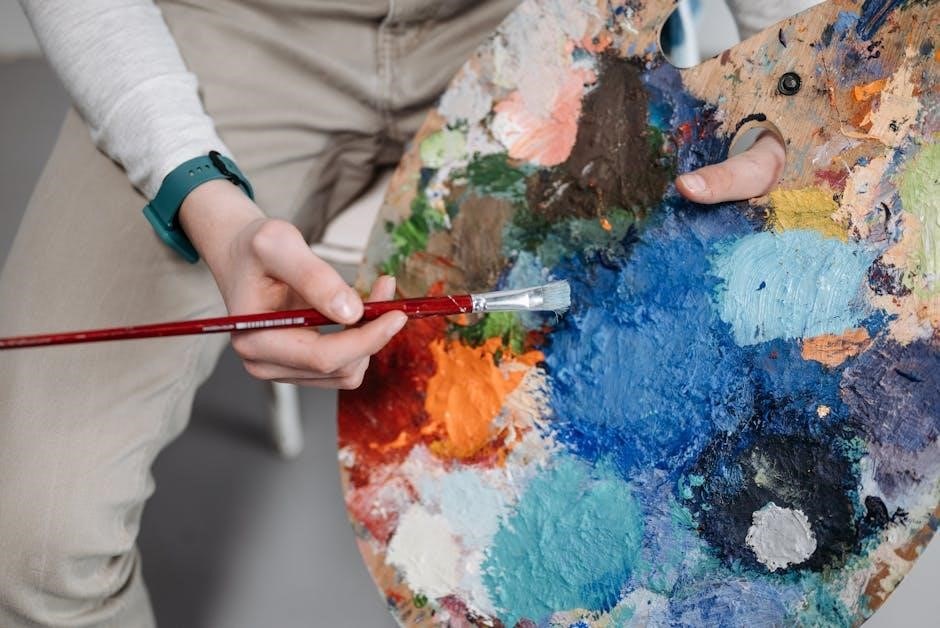
Advanced Techniques in Color Mixing
Advanced techniques involve layering, glazing, and using black and white for depth. A color mixing chart PDF helps master these methods, ensuring vibrant and balanced results.
8.1 Layering and Glazing Techniques
Layering and glazing are advanced methods that enhance depth and luminosity in artwork. A color mixing chart PDF aids in planning these techniques by showcasing how colors interact when layered or mixed with glazes. Layering involves applying multiple thin coats of paint to achieve rich, complex hues, while glazing adds transparent layers for subtle shifts in tone. These methods require precise color mixing, which a chart simplifies by providing visual references. By using a color mixing chart, artists can predict outcomes, ensuring consistency and vibrancy in their work. This approach is particularly useful for creating realistic shadows, highlights, and intricate details in paintings.
8.2 Using Black and White in Mixing
Black and white are essential for adjusting tone and contrast in color mixing. A color mixing chart PDF demonstrates how adding black or white to hues creates shades, tints, and tones. Black deepens colors, while white lightens them, enabling artists to achieve precise control over brightness and saturation. This technique is crucial for creating balanced palettes and adding depth to artwork. By referencing a color mixing chart, artists can predict how black and white will influence their colors, ensuring desired outcomes. This method is particularly useful for fine-tuning compositions and enhancing visual impact in paintings and digital designs.
8.3 Creating Vibrant and Balanced Palettes
Creating vibrant and balanced palettes is a cornerstone of effective color mixing. A color mixing chart PDF serves as a valuable resource, helping artists select harmonious color combinations. By understanding the 60-30-10 rule, where 60% of the palette is a dominant color, 30% a secondary, and 10% an accent, artists can craft visually appealing compositions. The chart also illustrates how to introduce contrast and depth by strategically using black and white to adjust tones. This approach ensures palettes are neither overwhelming nor dull, making it ideal for both digital and traditional artists aiming to enhance their work with dynamic yet balanced color schemes.
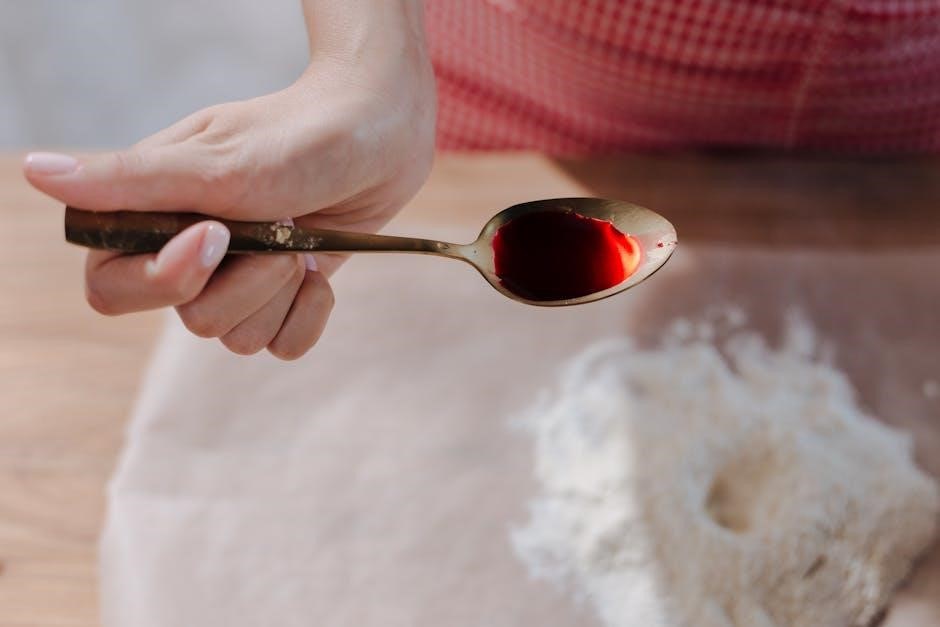
Troubleshooting Common Mixing Issues
A color mixing chart PDF helps resolve issues like muddy mixes or unwanted hues by providing clear guidelines for adjusting ratios and using black/white for tone corrections.
9.1 Fixing Muddy or Unwanted Colors
Muddy or unwanted colors often result from over-mixing or incorrect ratios. A color mixing chart PDF provides a visual guide to adjust proportions and identify the root cause. By referencing the chart, artists can learn to balance hues and avoid excessive blending. Adding small amounts of black or white can refine tones without muddying the mix. Testing color ratios on a separate palette before applying them to the final piece ensures accuracy. This method prevents wasted paint and time, helping artists achieve the desired shades efficiently. The chart also offers insights into complementary colors, which can neutralize unwanted tones effectively.
9.2 Adjusting Color Ratios
Adjusting color ratios is crucial for achieving desired hues in paintings. A color mixing chart PDF serves as a valuable reference, helping artists understand how to proportionally mix colors. By following the chart, one can avoid overwhelming a mix with too much of a single color. Adding small increments of black or white can refine tones without altering the base hue. Testing ratios on a separate palette ensures accuracy before applying them to the artwork. This method allows for precise control and consistency, making it easier to replicate colors in future projects. The chart also educates on how colors interact, enabling informed adjustments for optimal results.
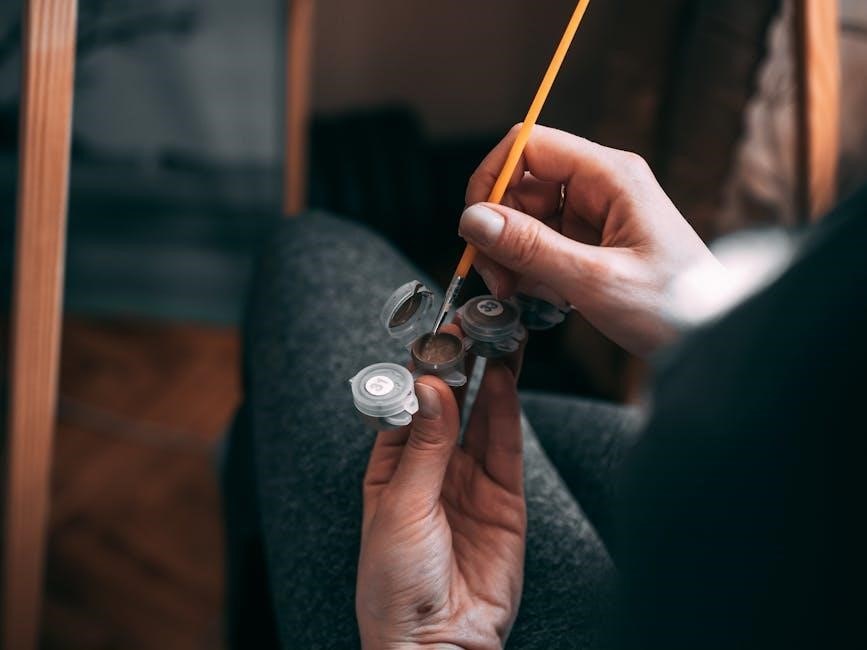
9.3 Correcting Color Inaccuracies
Correcting color inaccuracies is essential for achieving the desired hues in paintings. A color mixing chart PDF provides a detailed guide to identify and fix mismatches. Even slight discrepancies in color ratios can significantly impact the final result. By referencing the chart, artists can test and adjust colors on a separate palette before applying them to the artwork. Understanding the properties of primary, secondary, and tertiary colors helps in making precise corrections. Additionally, using black or white to refine tones can restore balance to a mix. This process ensures consistency and accuracy, allowing artists to learn from mistakes and improve their color mixing skills over time.
A color mixing chart PDF is an invaluable resource for mastering color theory and mixing techniques. Explore recommended books, online courses, and guides for further learning and artistic growth.
10.1 Summary of Key Points
A color mixing chart PDF is an essential tool for artists, providing a visual guide to color theory and mixing ratios. It simplifies creating custom color combinations, ensuring consistent results in paintings. These charts are ideal for both beginners and experienced artists, helping to prevent muddy mixes and achieve vibrant, balanced palettes. By understanding primary, secondary, and tertiary colors, as well as proportional mixing and tone adjustments, artists can enhance their creative process. Additionally, resources like the Liquitex Color and Pigment Chart and digital tools offer further guidance, making color mixing charts indispensable for mastering color theory and improving artistic skills.
10.2 Recommended Books and Guides
For deeper insights into color mixing, consider Stephen Quiller’s Color Choices, a comprehensive guide offering practical examples and expert tips. Additionally, the Liquitex Color and Pigment Chart is a valuable resource for understanding paint properties. A detailed guidebook on color theory and mixing is also available, providing summaries of essential charts and techniques. These resources are ideal for artists seeking to refine their skills and explore advanced color mixing methods. They can be found in online marketplaces or as downloadable PDFs, making them easily accessible for continuous learning and reference.
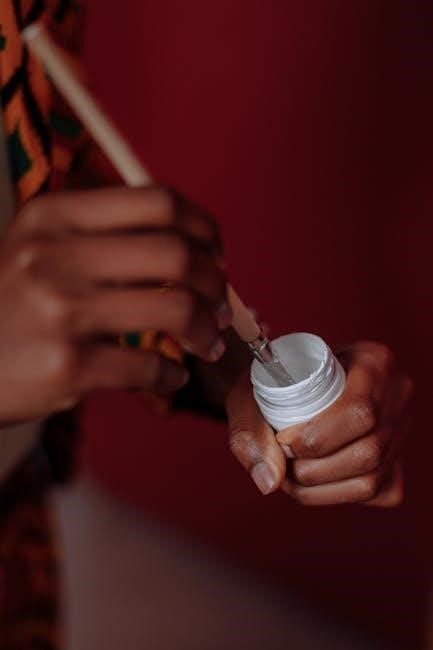
10.3 Online Courses and Tutorials
Enhance your color mixing skills with online courses and tutorials designed for artists. Platforms like The Virtual Instructor offer free and paid courses, covering topics from basic color theory to advanced mixing techniques. Video tutorials provide step-by-step guidance, while downloadable resources like PDF guides and printable templates complement your learning. These courses are ideal for both beginners and experienced artists, offering flexible learning opportunities. Additionally, websites like Teachable and YouTube host masterclasses and workshops, ensuring you can master color mixing at your own pace. These resources are perfect for refining your artistic skills and exploring new creative possibilities.
